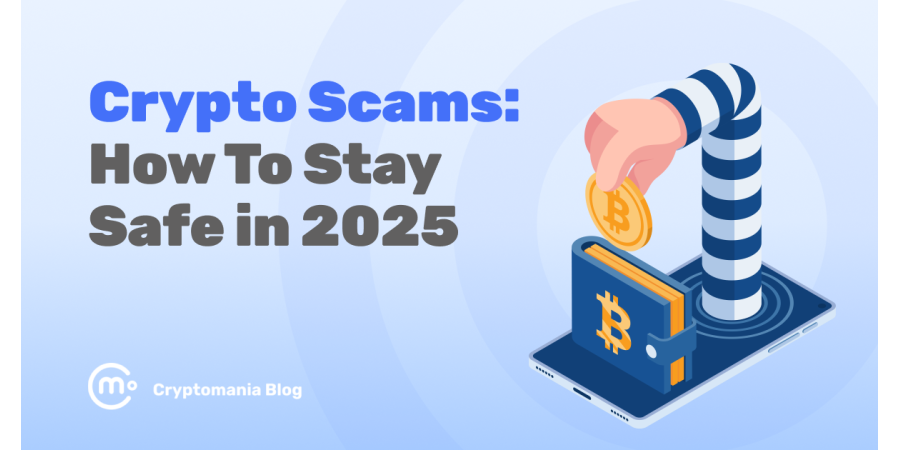How Do Crypto Scams Work in 2025 (and How to Protect Yourself)
Vuk Martinovic


The app looked legit. Clean charts, quick deposits, and “daily returns” that kept climbing.
Then withdrawals stopped. A pop-up said the funds were “on hold,” and a “tax clearance fee” was due to release them. Pay the fee, or lose everything. That is a classic playbook, updated for 2025, now boosted by AI voice clones and deepfake promos.
In this guide, I’ll explain:
- How crypto scams work today
- The most common scams right now
- How to spot trouble early
- What to do if you have already been hit
Let’s get started!
What are crypto scams?
A crypto scam is any scheme that tricks you into sending digital assets or revealing private credentials, then blocks withdrawals or disappears. The format varies, but the core is the same: false claims, social engineering, and fast exits.
Common motives and targets:
- Thieves chase quick cash, often moving funds across chains to confuse tracking.
- Targets include new investors, high-yield chasers, meme coin hunters, and anyone who responds to urgency or fear.
- Businesses and creators are hit too, often through hijacked social accounts or fake brand deals.
These schemes are illegal in most countries. Fraud, theft, and market manipulation laws apply, even if the asset is a token.
Regulators and law enforcement treat these as crimes, not “buyer beware” moments.
How do crypto scams work?
Scammers usually use a consistent funnel. The tech changes, the script stays familiar.
1. Build trust: They use social proof and fake authority. That could mean an influencer endorsement, a “verified” profile, or a polished website with audits, testimonials, and countdown timers.
2. Hook with greed or fear: Common lines include “guaranteed returns,” “exclusive airdrop,” or “urgent account warning.” Free money or urgent risk, both push fast action.
3. Move you off the safe pat: They steer you to a fake site, a counterfeit app, or a cloned customer support chat. You are told to connect your wallet, share a seed phrase, or buy a token on a “partner” exchange.
4. Extract value:
- Phishing links grab your credentials.
- Drainer contracts empty your wallet after you approve a transaction.
- Fake exchanges show “profits,” but withdrawals are locked behind made-up fees.
5. Disappear or stall: Once funds move, scammers cut contact or push you into paying more. Recovery fees, verification fees, tax fees. All fake.
Tactics you will see again and again:
- “Guaranteed returns” and “risk-free” offers.
- Fake giveaways where you must connect a wallet to claim.
- Impersonation of brands, founders, support teams, or government officials.
- Spoofed sites that look almost the same as the real thing, one letter off in the domain.
I’d say the bottom line is this: if you must act now, pay a fee to unlock funds, or connect a wallet for “free” tokens, you are in the danger zone.
The latest crypto scams in 2025
Scammers iterate fast. Here’s what’s trending now.
- Pump-and-dump tokens: Low-liquidity coins are hyped on social media, then insiders dump on buyers. Some launch platforms have been flooded with junk tokens. Reports tied to Solana’s Pump.fun suggest a huge share of tokens there in 2024 were outright scams. The pattern carries into 2025.
- Ramp-and-dump schemes: A newer twist. Hacked brokerage accounts buy thinly traded foreign stocks to push prices up, then dump. It mirrors crypto pumps, without the meme coin gloss. U.S. authorities have ongoing investigations in 2025.
- Fake airdrops with drainer kits: “Connect to claim” offers are bait. Criminals use drainer-as-a-service kits that anyone can rent. One bad approval, and your wallet empties.
- Deepfake influencer endorsements: AI-generated videos show famous figures backing a coin, a fund, or a “limited offer.” It looks real enough to lower your guard. Expect more of this as tools get cheaper.
- Rising crypto bot scams: Two angles are popular. Bots inflate volume to make a coin look hot. Chatbots pose as helpers, friends, or romantic partners, then guide you to bad links or fake platforms.
- Rug pulls: Developers spin up a token, pump it, lock you with fake liquidity, then vanish with the pool. The coin collapses to near zero, and the website goes dark.
- Impersonation and payment threats: Scammers posing as agencies or banks demand payment in crypto, or claim your account is at risk unless you “verify” on a link. Real institutions will not ask you to pay in crypto.
How to spot crypto scams early
Most scams leak red flags. I suggest you learn to spot them before you click.
Here are some of the core red flags:
- Unrealistic promises, like “2 percent daily” or “guaranteed APY.”
- Anonymous teams with no credible history or public repos.
- Unverified accounts with recent creation dates and sudden follower spikes.
- Withdrawals that require fees paid first.
- A new project that only exists on Telegram or X, no docs or code.
- Websites with lookalike domains, tiny misspellings, or copied design.
How to recognize crypto scams on Instagram and Cash App:
- Instagram
- Fake accounts in comments replying “DM support” or “contact recovery.”
- Stories that push urgent airdrops, with swipe-up links to unknown sites.
- Deepfake reels of influencers pitching coins. Audio sync and eye blinks can feel off.
- Cash App
- “Flip” scams that promise to multiply your money if you send first.
- Fake support asking for your sign-in code or remote access to your phone.
- QR codes that route to crypto deposit addresses not controlled by you.
Example warnings you might see in DMs:
- “Congrats, you are eligible for our exclusive airdrop. Connect your wallet to claim now.”
- “We noticed irregular activity. Verify your account here to avoid suspension.”
- “I turned 500 dollars into 5,000 in two days. I can do it for you, just send your seed phrase so we can trade.”
Never share a seed phrase. Ever. Anyone asking for it is a thief.
Quick checklist
- Search the team’s names, GitHub, and LinkedIn.
- Read the contract or find a reputable audit, not a fake badge.
- Use a burner wallet for any new site.
- Test withdrawals before adding more funds.
- Pause if you feel rushed.
Tinder and dating app crypto scams
Romance scams moved into crypto because it scales well and feels personal.
Here’s what these scams look like on Tinder and dating apps:
- The match seems perfect. They share your hobbies, text often, and move the chat to WhatsApp or Telegram quickly.
- After a few days or weeks, they talk about “learning to trade” or a “private platform” they use. Screenshots show big wins.
How scammers mix romance with investment pitches:
- They build trust first, then guide you to deposit small amounts. You see fake profits.
- You are encouraged to “just try a bit more,” with larger deposits.
- When you ask to withdraw, they block it behind a “verification” or tax fee.
Example flow of a “pig-butchering” scam:
- Grooming: Daily chats, sweet photos, coordinated time zones. They mirror your schedule and values.
- Seeding the idea: They casually share a win, or a relative who “knows a trick,” or a special exchange invite.
- Initial deposit: You send a modest amount. The site shows quick gains. You can sometimes withdraw a tiny amount to build trust.
- Bigger deposit: They push you to go larger, often with a deadline. You send thousands.
- Lock-in: Withdrawals are frozen. A pop-up asks for fees. Support chats are fake and scripted.
- Vanish: Once you refuse to pay more, they stop replying. Profiles disappear or shift to new victims.
The pattern is optimized to squeeze maximum value, then cut contact.
How to report crypto scams
Report fast. It increases the odds of freezing funds or flagging addresses.
Where to report:
- Exchanges
- Contact the exchange where you sent funds. Provide transaction IDs, addresses, and timestamps. Ask for an urgent account review.
- If funds moved through multiple exchanges, send the same packet to each.
- Local authorities
- File a police report with all evidence: wallet addresses, screenshots, chat logs, websites, and domain info.
In the U.S., report to the FTC and the Internet Crime Complaint Center. In the EU, contact Europol through national channels.
- File a police report with all evidence: wallet addresses, screenshots, chat logs, websites, and domain info.
- Social platforms
- Instagram: report the profile or post, select “scam or fraud,” and attach screenshots. Also, secure your own account with 2FA.
- Cash App: in the app, tap Activity, choose the payment, and select “Need Help & Cash Support.” Report the issue and block the user. Warn that you suspect fraud.
Why quick reporting is important:
- Exchanges may freeze assets or flag addresses.
- Platforms can remove fake pages and limit further damage.
- Law enforcement can link reports across cases, which helps tracing.
Keep copies of every message, receipt, and confirmation email. Organize your files by date.
How to get money back from crypto scams
Set expectations. Recovery is not impossible, but it’s hard and not very likely.
What you can realistically expect:
- If funds went to a known exchange and remain there, there is a chance of a freeze.
- If funds moved through mixers or cross-chain bridges quickly, recovery odds drop.
What blockchain tracing and recovery services can do:
- Trace funds across chains, label addresses, and prepare evidence packages.
- Work with exchanges and law enforcement to request holds or disclosures.
- Coordinate civil or criminal action if funds are found on compliant platforms.
Before you hire anyone, ask:
- Do they provide a written scope and fee structure?
- What tools or partners do they use?
- Can they share de-identified case references?
- Do they require upfront payment in crypto? That is a red flag.
Why victims should avoid “recovery scams”:
- These groups contact you first, claim they have already found your funds, and ask for a fee.
- They pretend to be from an agency or exchange.
- They deliver nothing after payment, then refer you to yet another “partner.”
- Real firms do not promise outcomes, and they do not demand your seed phrase.
Practical next steps after a loss:
- Revoke approvals on all wallets. Use a trusted revocation tool.
- Move remaining assets to a new wallet with a fresh seed.
- Rotate passwords, enable 2FA, and secure email accounts.
- File your reports, then consider a consultation with a reputable investigator.
Spot the scam: a quick reference table
| Red flag | What it really means | What to do |
| Guaranteed daily returns | Fabricated profits, classic Ponzi pattern | Walk away, report the ad |
| Connect wallet to claim airdrop | Drainer risk using malicious approvals | Use a burner wallet, or skip entirely |
| Withdrawal requires a fee first | Fake fees, no intent to release funds | Do not pay, collect evidence, report |
| Anonymous team, no code or audit | Zero accountability, likely rug risk | Avoid, wait for real audits |
| DM from “support” or “recovery” | Impersonation aiming for keys or access | Do not reply, report the profile |
| Urgent deadline, “only 24 hours” | Pressure tactic to bypass due diligence | Slow down, verify through official channels |
Safer habits that actually work
- Start small: Test any platform with an amount you can lose. Attempt a withdrawal early.
- Use hardware wallets: Keep long-term funds offline. Only connect hot wallets to sites you trust.
- Split funds: Do not keep everything in one place. Use separate wallets for trading and storage.
- Verify domains and apps: Bookmark official links. Download apps from official stores, then verify developer names.
- Read approvals: Check what a contract can spend before you sign. Deny if anything seems off.
- Keep your circle small: Do not share screenshots of balances. Do not brag about wins in public groups.
A closer look at deepfakes and bot scams
Deepfake promos are often tied to “limited-time funds” or “AI trading platforms.”
The video quality can be high, but the messaging feels generic. The website is new, the team is “global,” and contact info is minimal. Treat every celebrity coin promo as fake until proven otherwise.
Bots are doing two jobs for scammers:
- Fake volume and liquidity to make a chart or market feel alive.
- Automated chats that mimic human warmth, answer basic questions, and nudge you to connect a wallet or deposit.
A human finishes the con once the bot warms you up.
If you think you are looking at a scam, do this:
- Screenshot everything, including headers and URLs.
- Copy the wallet address and transaction IDs.
- Check for known reports on crypto scam databases.
- Ask a trusted friend or community mod for a second opinion.
- Stop sending money. Do not pay “release fees.”
Education beats urgency
Scammers count on speed, shame, and silence. Break that pattern.
- Talk to someone you trust before you act.
- Sleep on any big decision.
- Use checklists and burner wallets when you test new sites.
The bottom line
Crypto can be exciting, but it’s also a magnet for cons. The key is education and staying calm.
You learned how crypto scams work, what is trending in 2025, how to spot early red flags, where to report, and what recovery looks like. Keep your habits tight, confirm links, and question “guaranteed” anything.
If something feels off, it probably is. If you’re not sure, it’s better to be too cautious than not cautious enough.
Share this with a friend, and keep your keys, your coins, and your peace of mind.





